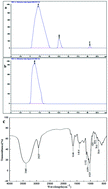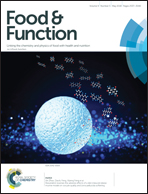Structural characterization and antitumor activity of a novel Se-polysaccharide from selenium-enriched Cordyceps gunnii
Abstract
Selenium (Se) has been recognized as an essential element. Animals and humans absorb and retain more organic Se than inorganic Se. Bio-transformation is a major approach to transform inorganic Se to organic Se. Cordyceps gunnii (C. gunnii), well known as a Chinese edible and medicinal fungus, has a variety of biological functions. C. gunnii and selenium were combined through liquid-fermentation to obtain selenium-enriched C. gunnii. A novel Se-polysaccharide (SeCPS-II) was extracted from selenium-enriched C. gunnii. The molecular weight, sugar content and selenium content of SeCPS-II were 4.12 × 103 kDa, 17.89 μg g−1 and 90.75%, respectively. The structure of SeCPS-II was characterized using FT-IR, NMR, GC and GC-MS studies. SeCPS-II was composed of pyranose, which contained α-L-rhamnose, α-D-mannose, α-D-glucose and β-D-galactose at a ratio of 4.33 : 12.62 : 27.50 : 18.99. SeCPS-II contained α-(1 → 4)-D-glucose, α-(1 → 3)-D-glucose, β-(1 → 6)-D-galactose, α-(1 → 6)-D-mannose, and α-(1 → 4)-L-rhamnose, and the main chain was composed of α-(1 → 4)-D-glucose. An MTT assay indicated that SeCPS-II could influence the cell viability of SKOV-3 cells, H1299 cells and HepG2 cells in a dose-dependent and time-dependent manner. Morphologic changes (AO/EB staining and DAPI staining) and an MMP assay (JC-1 staining) of SKOV-3 cells treated with SeCPS-II were performed to research the antitumor activity of SeCPS-II. SeCPS-II could significantly induce apoptosis in SKOV-3 cells with typical apoptotic characteristics. To study the mechanism, the expressions of caspase-3, caspase-9, PARP, p53, Bax and Bcl-2 in SKOV-3 were studied via western blotting. SeCPS-II can stimulate the apoptosis of SKOV-3 cells through the p53-Bax-caspase pathway. Animal experiments revealed that SeCPS-II inhibits tumors within an ovarian tumor model rat, modeled with SKOV-3 cells. All the results indicated that selenium-enriched C. gunnii can be used to develop new selenium-containing additives.



 Please wait while we load your content...
Please wait while we load your content...